Tribological Behavior of Sulfonated Polyether Ether Ketone with Three Different Chemical Structures under Water Lubrication
Abstract
1. Introduction
2. Materials and Methods
2.1. Materials
2.2. Synthesis of the SPEEK Powders
2.3. Sintering Procedure
2.4. Characterization
2.5. Tribological and Mechanical Tests
3. Results and Discussion
3.1. Analysis of the SPEEK Powders
3.2. Thermal Properties Analysis
3.3. Tribology and Mechanical Analysis
4. Conclusions
- The appropriate introduction of the groups can significantly reduce friction and wear through hydration lubrication and slightly enhance mechanical properties. The friction coefficients of SMPEEK, STPEEK, and STDPEEK were significantly reduced by 48%, 40%, and 30%, respectively, and the wear rates were correspondingly reduced by 58%, 51%, and 59%, respectively.
- The volume of side groups and rigid segments had a significant influence on tribological properties. It was described that the rotation and relaxation of molecular chains were influenced by the restriction of steric hindrance and entanglement between molecular chains.
- The SMPEEK exhibited superior anti-friction and anti-wear performance among the three chemical structures. The friction coefficient of SMPEEK could reach a value of 0.044 when subjected to a normal load of 15 N and a sliding speed of 50 mm/s under 3 wt% NaCl aqueous solution, and the wear rate was as low as 10−8 mm3/(N m). In addition, stability and low-cost monomers provided the premise for industrial application. In the future research, the tribological and mechanical properties can be further improved by fillers to meet the requirements of extreme working conditions. It indicated that SPEEK had great potential and advantages in water-lubricated bearings.
Author Contributions
Funding
Institutional Review Board Statement
Data Availability Statement
Conflicts of Interest
References
- Luo, J.B.; Zhou, X. Superlubricitive engineering-future industry nearly getting rid of wear and frictional energy consumption. Friction 2020, 8, 643–665. [Google Scholar] [CrossRef]
- Hou, X.; Bai, P.P.; Li, J.Y.; Li, Y.Z.; Cao, H.; Wen, X.L.; Meng, Y.J.; Ma, L.R.; Tian, Y. MoS2 reinforced PEEK composite for improved aqueous boundary lubrication. Friction 2023, 11, 1660–1672. [Google Scholar] [CrossRef]
- Luo, J.B.; Liu, M.; Ma, L.R. Origin of friction and the new frictionless technology-superlubricity: Advancements and future outlook. Nano Energy 2021, 86, 106092. [Google Scholar] [CrossRef]
- Holmberg, K.; Erdemir, A. Influence of tribology on global energy consumption, costs and emissions. Friction 2017, 5, 263–284. [Google Scholar] [CrossRef]
- Holmberg, K.; Erdemir, A. The impact of tribology on energy use and CO2 emission globally and in combustion engine and electric cars. Tribol. Int. 2019, 135, 389–396. [Google Scholar] [CrossRef]
- Liu, H.; Yang, B.M.; Wang, C.; Han, Y.S.; Liu, D.M. The mechanisms and applications of friction energy dissipation. Friction 2022, 11, 839–864. [Google Scholar] [CrossRef]
- Ginzburg, B.M.; Tochil’nikov, D.G.; Bakhareva, V.E.; Anisimov, A.V.; Kireenko, O.F. Polymeric materials for water-lubricated plain bearings. Russ. J. Appl. Chem. 2006, 79, 695–706. [Google Scholar] [CrossRef]
- Xie, Z.L.; Jiao, J.; Yang, K.; Zhang, H. A state-of-art review on the water-lubricated bearing. Tribol. Int. 2023, 180, 108276. [Google Scholar] [CrossRef]
- Zhang, Z.; Ouyang, W.; Liang, X.X.; Yan, X.P.; Yuan, C.Q.; Zhou, X.C.; Guo, Z.W.; Dong, C.L.; Liu, Z.L.; Jin, Y.; et al. Review of the evolution and prevention of friction, wear, and noise for water-lubricated bearings used in ships. Friction 2023, 12, 1–38. [Google Scholar] [CrossRef]
- Raviv, U.; Laurat, P.; Klein, J. Fluidity of water confined to subnanometre films. Nature 2001, 413, 51–54. [Google Scholar] [CrossRef]
- Li, X.F.; Guo, Z.W.; Huang, Q.R.; Yuan, C.Q. Application of bionic tribology in water-lubricated bearing: A review. J. Bionic Eng. 2022, 19, 902–934. [Google Scholar] [CrossRef]
- Klein, J. Hydration lubrication. Friction 2013, 1, 1–23. [Google Scholar] [CrossRef]
- Wang, H.J.; Liu, Z.L.; Zou, L.; Yang, J. Influence of both friction and wear on the vibration of marine water lubricated rubber bearing. Wear 2017, 376, 920–930. [Google Scholar] [CrossRef]
- Dong, C.L.; Yuan, C.Q.; Bai, X.Q.; Qin, H.L.; Yan, X.P. Investigating relationship between deformation behaviours and stick-slip phenomena of polymer material. Wear 2017, 376, 1333–1338. [Google Scholar] [CrossRef]
- Wu, Z.M.; Guo, Z.W.; Yuan, C.Q. Insight into water lubrication performance of polyetheretherketone. J. Appl. Polym. Sci. 2021, 138, e49701. [Google Scholar] [CrossRef]
- Jiang, S.L.; Guo, Z.W.; Yuan, C.Q.; Liu, A.X.; Bai, X.Q. Study on the tribological properties of modified polyurethane material for water-lubricated stern bearing. J. Appl. Polym. Sci. 2018, 135, 46305. [Google Scholar] [CrossRef]
- Deng, M.M.; Li, J.J.; Zhang, C.H.; Ren, J.; Zhou, N.N.; Luo, J.B. Investigation of running-in process in water-based lubrication aimed at achieving super-low friction. Tribol. Int. 2016, 102, 257–264. [Google Scholar] [CrossRef]
- Higaki, Y.J.; Kobayashi, M.; Takahara, A. Hydration state variation of polyzwitterion brushes through interplay with ions. Langmuir 2020, 36, 9015–9024. [Google Scholar] [CrossRef]
- Drummond, C.; Israelachvili, J.; Richetti, P. Friction between two weakly adhering boundary lubricated surfaces in water. Phys. Rev. E 2003, 67, 066110. [Google Scholar] [CrossRef]
- Briscoe, W.H. Aqueous boundary lubrication: Molecular mechanisms, design strategy, and terra incognita. Curr. Opin. Colloid Interface Sci. 2017, 27, 1–8. [Google Scholar] [CrossRef]
- Fang, Y.F.; Ma, L.R. Mechanic model of water-based boundary lubricated contact based on surface force effects. Friction 2022, 11, 93–108. [Google Scholar] [CrossRef]
- Briscoe, W.H.; Klein, J. Friction and adhesion hysteresis between surfactant monolayers in water. J. Adhes. 2007, 83, 705–722. [Google Scholar] [CrossRef]
- Panayotov, I.V.; Orti, V.; Cuisinier, F.; Yachouh, J. Polyetheretherketone (PEEK) for medical applications. J. Mater. Sci. Mater. Med. 2016, 27, 118. [Google Scholar] [CrossRef] [PubMed]
- Shukla, D.; Negi, Y.S.; Uppadhyaya, J.S.; Kumar, V. Synthesis and Modification of Poly (ether ether ketone) and their Properties: A Review. Polym. Rev. 2012, 52, 189–228. [Google Scholar] [CrossRef]
- Zhang, G.; Zhang, C.; Nardin, P.; Li, W.Y.; Liao, H.; Coddet, C. Effects of sliding velocity and applied load on the tribological mechanism of amorphous poly-ether-ether-ketone (PEEK). Tribol. Int. 2008, 41, 79–86. [Google Scholar] [CrossRef]
- Awasthi, S.; Kiran, V.; Gaur, B. Crosslinked poly (ether ether ketone): Cost-effective proton exchange membranes for fuel cell application. Bull. Mater. Sci. 2018, 41, 9. [Google Scholar] [CrossRef]
- Huang, X.H.; Chen, Z.; Lin, P.; Huang, J.B.; Chen, W.J. Preparation of highly H+ permeable sulfonated poly (ether ether ketone) cation exchange membranes and their applications in electro-generation of thioglycolic acid. Polym. Int. 2009, 58, 715–719. [Google Scholar] [CrossRef]
- Lakshmi, R.T.S.M.; Haack, J.M.; Schlenstedt, K.; Vogel, C.; Choudhary, V.; Varma, I.K. Sulphonated poly (ether ether ketone) copolymers: Synthesis, characterisation and membrane properties. J. Membr. Sci. 2005, 261, 27–35. [Google Scholar] [CrossRef]
- Yuan, S.H.; Zhang, C.H. A sulfonated modification of PEEK for ultralow friction. Friction 2022, 11, 881–893. [Google Scholar] [CrossRef]
- Wu, M.S.; Hu, T.; Lan, J.Y.; Li, X.L.; Zhang, C.H.; Luo, J.B. Carbon fibre reinforced bisphenol-A type SPEEK composite for water lubricated superlubricity. Compos. Part A Appl. Sci. Manuf. 2024, 180, 108113. [Google Scholar] [CrossRef]
- Chang, G.J.; Shang, Z.F.; Yang, L. Hydrogen bond cross-linked sulfonated poly (imino ether ether ketone) (PIEEK) for fuel cell membranes. J. Power Sources 2015, 282, 401–408. [Google Scholar] [CrossRef]
- Li, H.T.; Cui, Z.M.; Zhao, C.J.; Wu, J.; Fu, T.Z.; Zhang, Y.; Shao, K.; Zhang, H.Q.; Na, H.; Xing, W. Synthesis and property of a novel sulfonated poly (ether ether ketone) with high selectivity for direct methanol fuel cell applications. J. Membr. Sci. 2009, 343, 164–170. [Google Scholar] [CrossRef]
- Zhong, S.L.; Liu, C.G.; Na, H. Preparation and properties of UV irradiation-induced crosslinked sulfonated poly (ether ether ketone) proton exchange membranes. J. Membr. Sci. 2009, 326, 400–407. [Google Scholar] [CrossRef]
- Xu, J.N.; Zhang, C.H.; Luo, J.B. Hydration lubrication applicable to artificial joints through polyelectrolyte-embedded modification on UHMWPE. ACS Appl. Polym. Mater. 2022, 4, 7487–7497. [Google Scholar] [CrossRef]
- Wang, A.Y.; Yan, S.A.; Lin, B.; Zhang, X.F.; Zhou, X.X. Aqueous lubrication and surface microstructures of engineering polymer materials (PEEK and PI) when sliding against Si3N4. Friction 2017, 5, 414–428. [Google Scholar] [CrossRef]
- Guo, F.; Wu, F.; Wu, F.Y.; Wang, Y.M. Low-friction mechanism of silicon carbide and cemented carbide in water. Proc. Inst. Mech. Eng. Part J-J. Eng. Tribol. 2021, 235, 945–951. [Google Scholar] [CrossRef]
- Wang, L.; Meng, Y.Z.; Wang, S.J.; Li, X.H.; Xiao, M. Synthesis and properties of sulfonated poly (arylene ether) containing tetraphenylmethane moieties for proton-exchange membrane. J. Polym. Sci. Part A Polym. Chem. 2005, 43, 6411–6418. [Google Scholar] [CrossRef]
- Zalaznik, M.; Kalin, M.; Novak, S. Influence of the processing temperature on the tribological and mechanical properties of poly-ether-ether-ketone (PEEK) polymer. Tribol. Int. 2016, 94, 92–97. [Google Scholar] [CrossRef]
- Kerres, J.; Cui, W.; Junginger, M. Development and characterization of crosslinked ionomer membranes based upon sulfinated and sulfonated PSU crosslinked PSU blend membranes by alkylation of sulfinate groups with dihalogenoalkanes. J. Membr. Sci. 1998, 139, 227–241. [Google Scholar] [CrossRef]
- Johansson, M.P.; Olsen, J. Torsional barriers and equilibrium angle of biphenyl: Reconciling theory with experiment. J. Chem. Theory Comput. 2008, 4, 1460–1471. [Google Scholar] [CrossRef]
- Wilhelm, R.; Dotsevi, Y.S. Synthesis of soluble high molecular weight poly (aryl ether ketones) containing bulky substituents. Macromolecules 1990, 23, 4029–4033. [Google Scholar] [CrossRef]
- Ikeda, T.; Boero, M.; Terakura, K. Hydration of alkali ions from first principles molecular dynamics revisited. J. Chem. Phys. 2007, 126, 034501. [Google Scholar] [CrossRef] [PubMed]
- Zhang, Z.H.; Nie, S.L.; Liao, W.J.; Li, L.; Yuan, S.H. Tribological behaviors of carbon fiber reinforced polyetheretherketone sliding against silicon carbide ceramic under seawater lubrication. Proc. Inst. Mech. Eng. Part J J. Eng. Tribol. 2014, 228, 1421–1432. [Google Scholar] [CrossRef]
- Zhang, J.J.; Liu, J.C.; Wang, Z.X.; Chen, W.; Hu, B.; Zhang, Y.; Liao, H.M.; Ma, S.D. Tribological behavior and lubricating mechanism of Si3N4 in artificial seawater. Ceram. Int. 2020, 46, 14361–14368. [Google Scholar] [CrossRef]
- Li, H.Q.; Liu, X.W.; Zhang, C.; Jiao, X.Y.; Chen, W.; Gao, J.H.; Zhong, L.S. Friction and wear properties of silicon nitride-based composites with different hBN content sliding against polyether-etherketone at different speeds under artificial seawater lubrication. Coatings 2022, 12, 411. [Google Scholar] [CrossRef]
- Wang, J.T.; Wasmus, S.; Savinell, R.F. Real-time mass spectrometric study of the methanol crossover in a direct methanol fuel cell. J. Electrochem. Soc. 1996, 143, 1233–1239. [Google Scholar] [CrossRef]
- Liu, X.X.; Li, T.S.; Liu, X.J.; Lv, R.G.; Cong, P.H. An investigation on the friction of oriented polytetrafluoroethylene (PTFE). Wear 2007, 262, 1414–1418. [Google Scholar] [CrossRef]
- Myshkin, N.; Kovalev, A.; Spaltman, D.; Woydt, M. Contact mechanics and tribology of polymer composites. J. Appl. Polym. Sci. 2013, 131, 39870. [Google Scholar] [CrossRef]
- Satyanarayana, N.; Sinha, S.K.; Shen, L. Effect of molecular structure on friction and wear of polymer thin films deposited on Si surface. Tribol. Lett. 2007, 28, 71–80. [Google Scholar] [CrossRef]
- Thomas, P. Dependence of the friction process on the molecular structure and architecture of thin polymer films. Tribol. Int. 1996, 29, 631–637. [Google Scholar] [CrossRef]
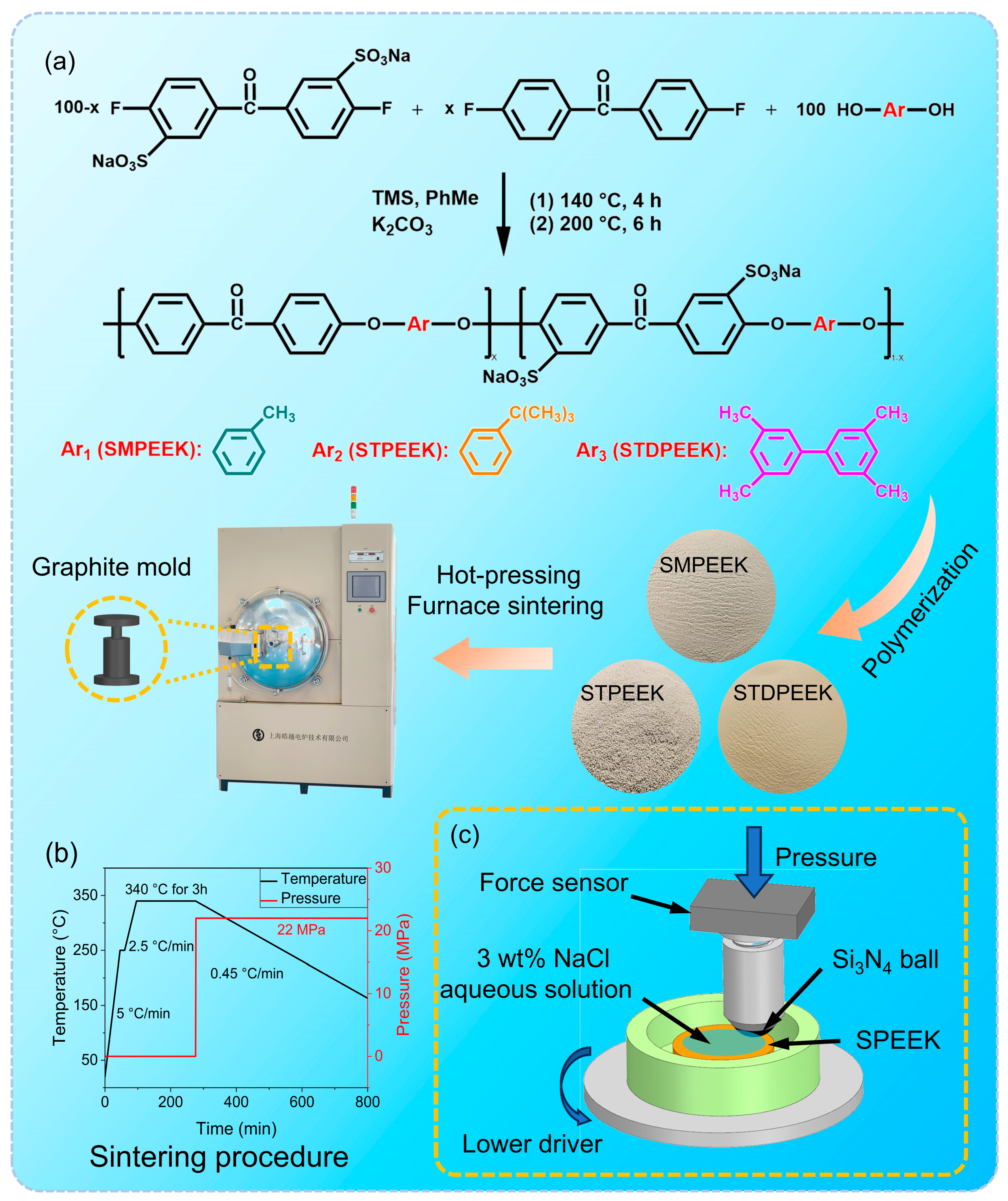
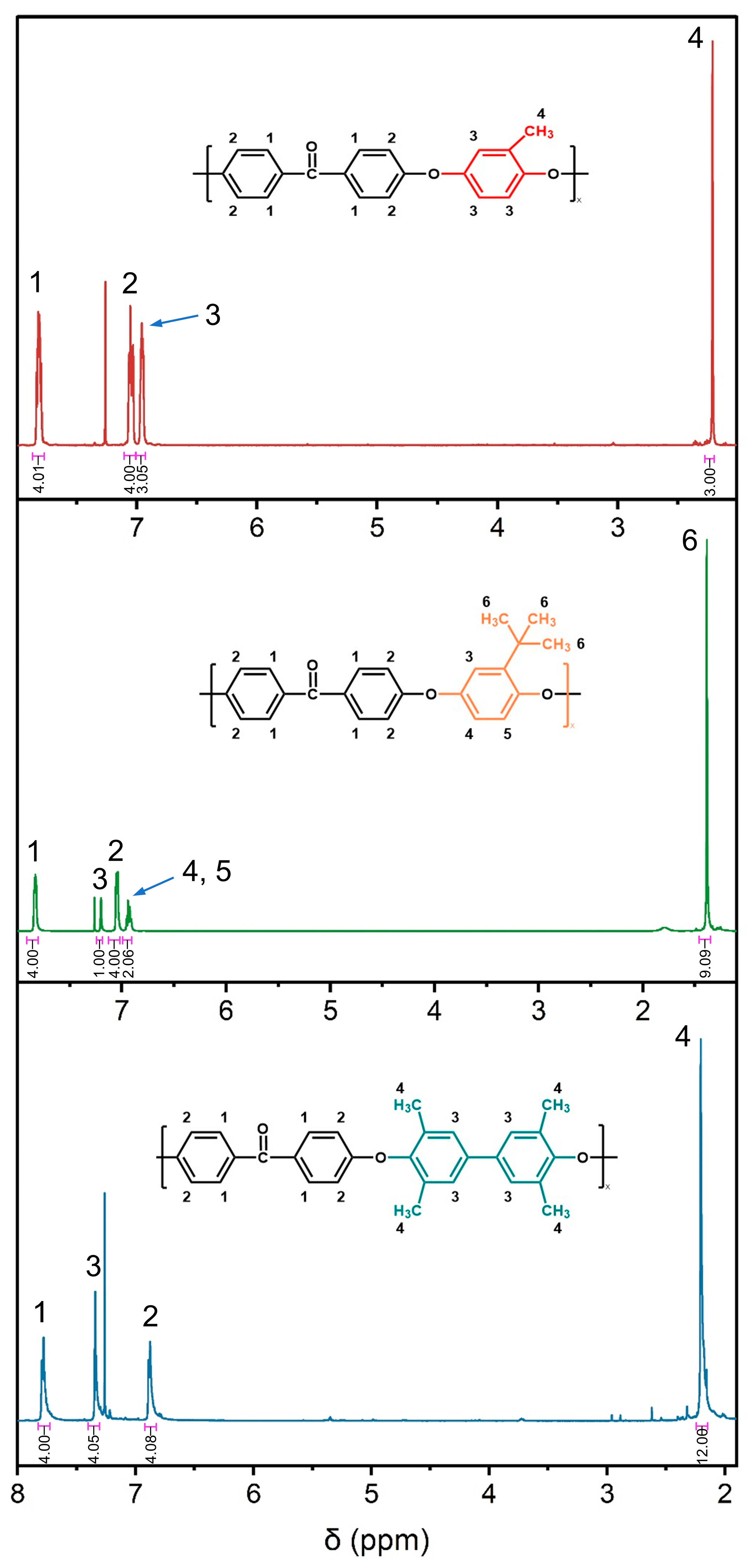
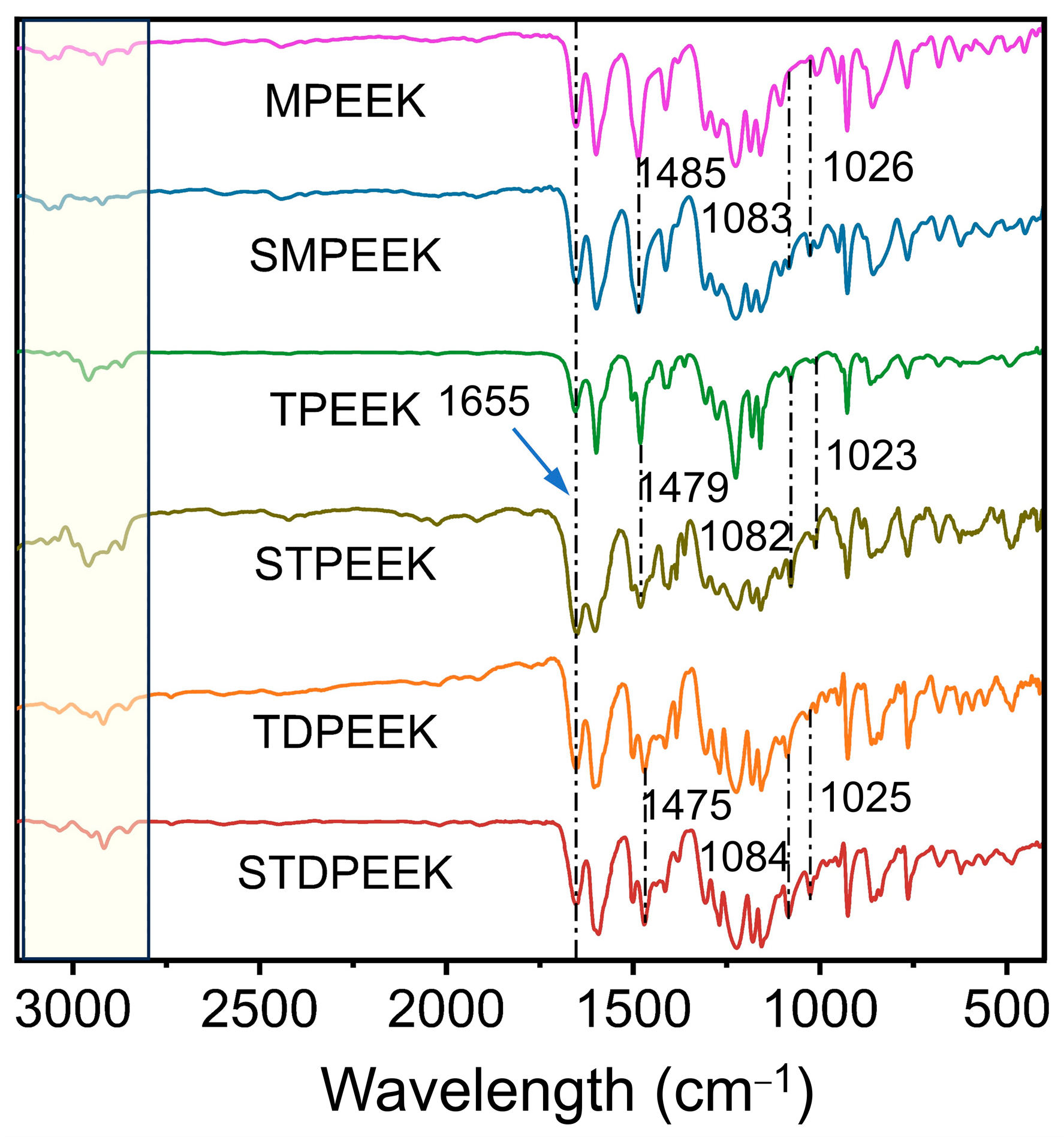
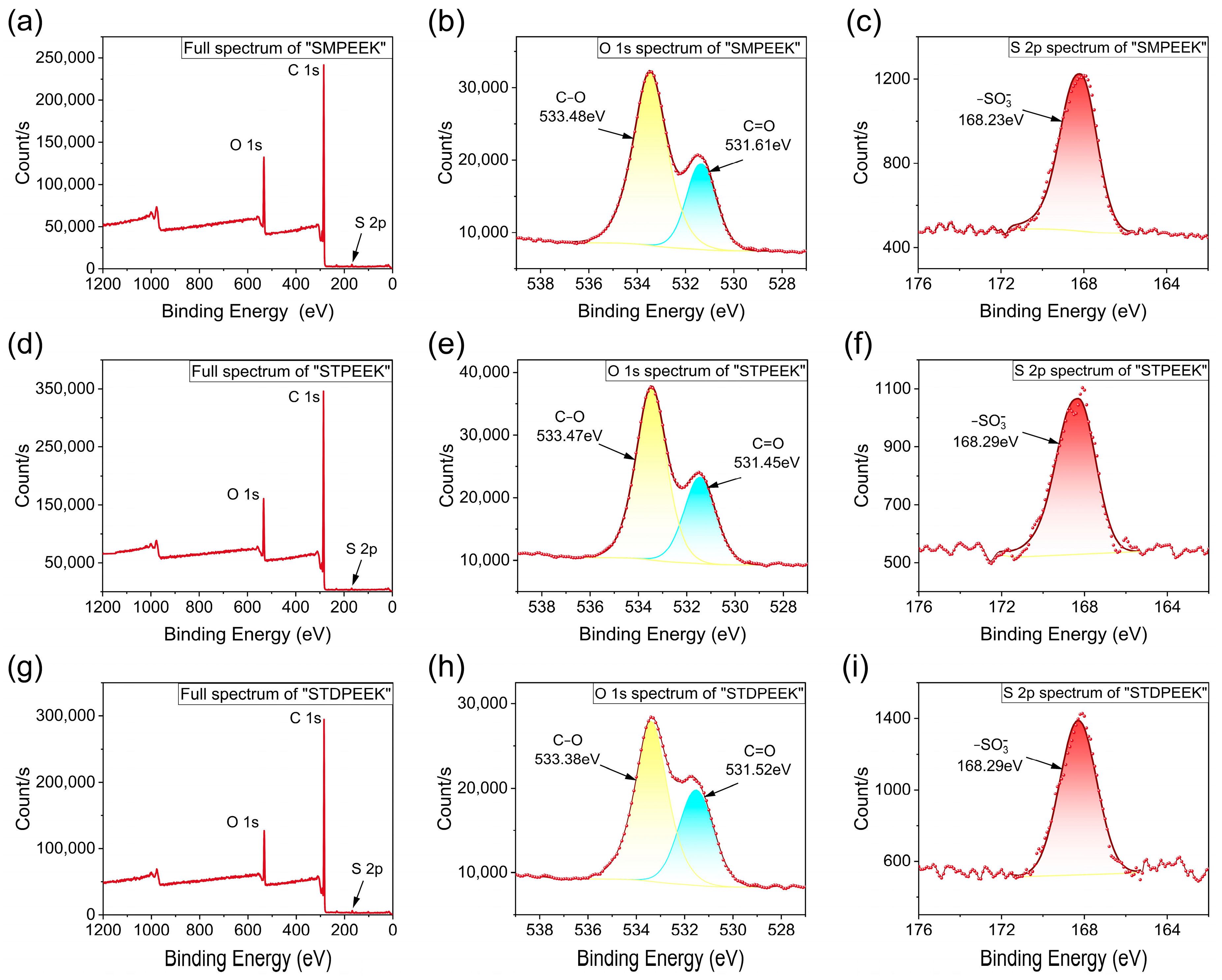
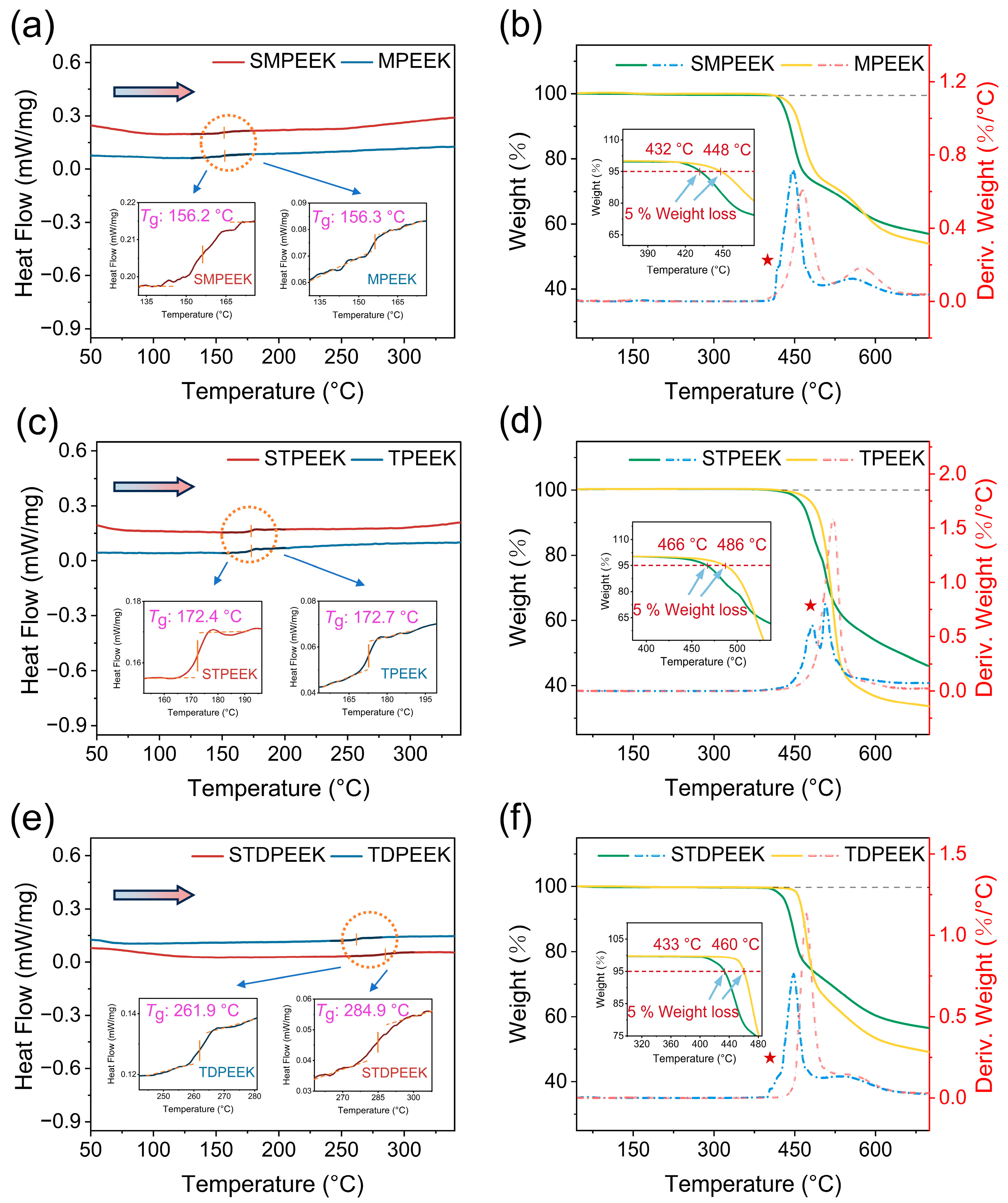



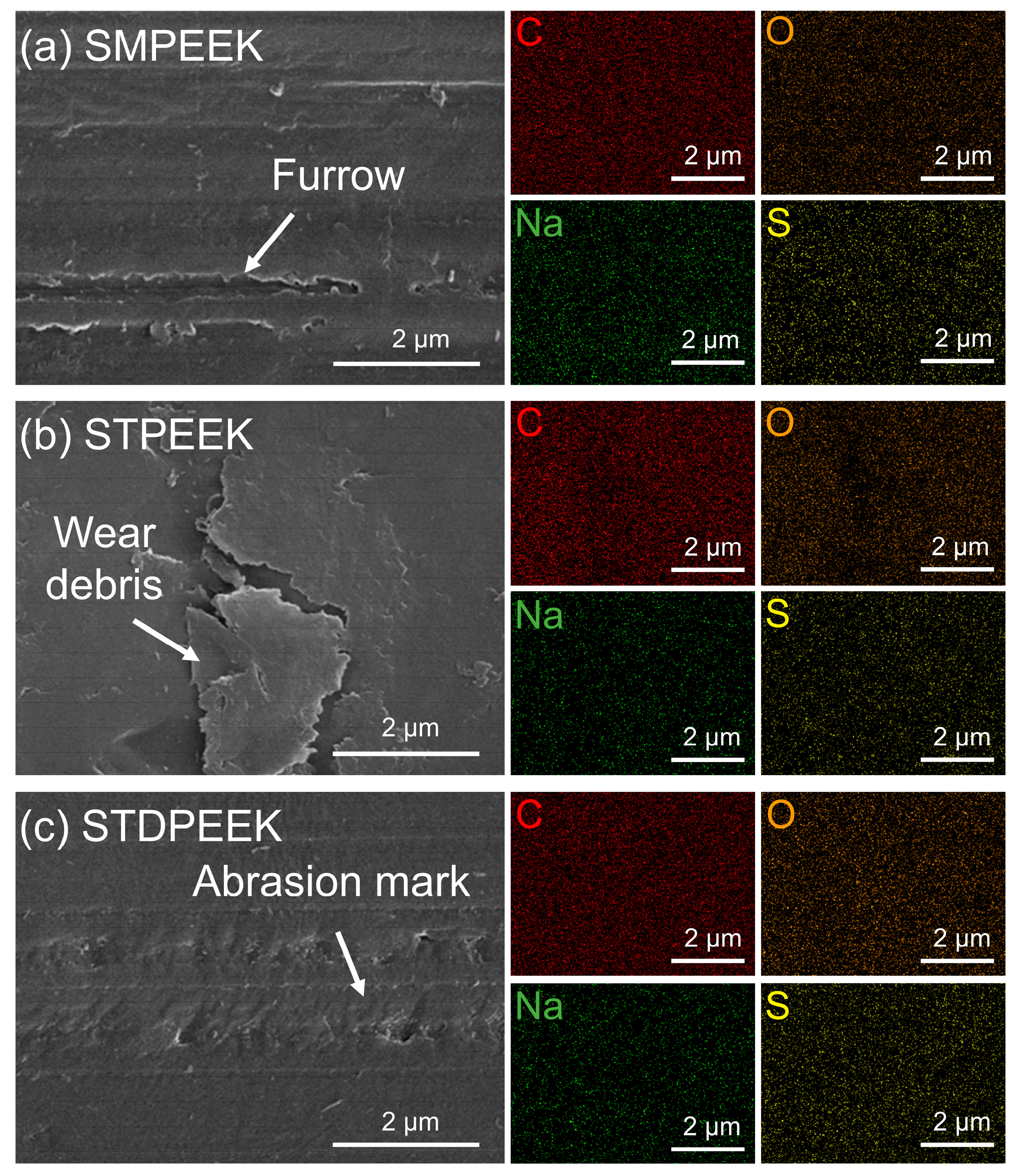
| Polymer | Monomer 1 (g) | Monomer 2 (g) | Monomer 3 (g) |
|---|---|---|---|
| MPEEK | 0 | 21.8 | 12.4 |
| TPEEK | 0 | 21.8 | 16.6 |
| TDPEEK | 0 | 21.8 | 24.2 |
| SMPEEK | 2.1 | 20.7 | 12.4 |
| STPEEK | 3.2 | 20.2 | 16.6 |
| STDPEEK | 3.2 | 20.2 | 24.2 |
| Polymer | Mn | Mw | Ds | D50 |
|---|---|---|---|---|
| SMPEEK | 6545 | 12,785 | 1.4 | 39 |
| STEEK | 11,761 | 20,689 | 2.6 | 53 |
| STDPEEK | 10,773 | 20,439 | 2.5 | 28 |
| Polymer | Young’s Modulus (GPa) | Shore Hardness (D) | Compressive Strength (MPa) | |||
|---|---|---|---|---|---|---|
| Mean Value | Standard Deviation | Mean Value | Standard Deviation | Mean Value | Standard Deviation | |
| MPEEK | 4.4 | 0.2 | 85 | 2 | 125 | 3.5 |
| TPEEK | 4.1 | 0.3 | 84 | 5 | 114 | 4.0 |
| TDPEEK | 3.1 | 0.2 | 83 | 3 | 102 | 2.7 |
| SMPEEK | 4.5 | 0.1 | 84 | 1 | 132 | 2.5 |
| STEEK | 4.1 | 0.2 | 83 | 4 | 118 | 2.8 |
| STDPEEK | 3.6 | 0.1 | 78 | 3 | 146 | 2.3 |
Disclaimer/Publisher’s Note: The statements, opinions and data contained in all publications are solely those of the individual author(s) and contributor(s) and not of MDPI and/or the editor(s). MDPI and/or the editor(s) disclaim responsibility for any injury to people or property resulting from any ideas, methods, instructions or products referred to in the content. |
© 2024 by the authors. Licensee MDPI, Basel, Switzerland. This article is an open access article distributed under the terms and conditions of the Creative Commons Attribution (CC BY) license (https://creativecommons.org/licenses/by/4.0/).
Share and Cite
Chen, X.; Hu, T.; Wu, W.; Yi, X.; Li, F.; Zhang, C. Tribological Behavior of Sulfonated Polyether Ether Ketone with Three Different Chemical Structures under Water Lubrication. Polymers 2024, 16, 998. https://doi.org/10.3390/polym16070998
Chen X, Hu T, Wu W, Yi X, Li F, Zhang C. Tribological Behavior of Sulfonated Polyether Ether Ketone with Three Different Chemical Structures under Water Lubrication. Polymers. 2024; 16(7):998. https://doi.org/10.3390/polym16070998
Chicago/Turabian StyleChen, Xiaozhi, Tao Hu, Wei Wu, Xiaohong Yi, Fenghua Li, and Chenhui Zhang. 2024. "Tribological Behavior of Sulfonated Polyether Ether Ketone with Three Different Chemical Structures under Water Lubrication" Polymers 16, no. 7: 998. https://doi.org/10.3390/polym16070998
APA StyleChen, X., Hu, T., Wu, W., Yi, X., Li, F., & Zhang, C. (2024). Tribological Behavior of Sulfonated Polyether Ether Ketone with Three Different Chemical Structures under Water Lubrication. Polymers, 16(7), 998. https://doi.org/10.3390/polym16070998







